Chassis 026

“It was quick and when it’s quick you like it and you win. If it’s slow you don’t like it (laughs) and you don’t win,” Niki Lauda quipped, quickly traversing Austin’s busy paddock.
There was a glimmer in the three time World Champion’s eye when asked to recall his Ferrari 312-T2, chassis 026. “When you drive these cars you never forget. So you cannot compare this with anything. It was a very well designed car for that time. Everything, everything was right and you could win.”
Indeed it was. Lauda arrived at Ferrari for the 1974 season to team with Technical Director Mauro Forghieri, a second generation Ferrari engineer who jump-started Ferrari’s resurrection with his experimental revisions to 1973’s lackluster 312 B3.
Unlike today’s tightly regulated, wind tunnel-derived hybrid formula, F1 constructors in the 1970’s were as free to experimentation as the climate of the decade itself. The merge of creativity and technology in Grand Prix racing was in shifting into high gear. The 1974 season would be a turning point and over the next three years, Lauda and Forghieri, with further credit to Clay Reggazoni, would together haul the Scuderia from obscurity to write a new chapter in F1 history.
Ferrari returned to the top in 1975 with the 312-T, which introduced a transversally mounted gearbox forward the rear axle. Once described by Lauda as “magnificent,” the T was “a permanent monument to Forghieri’s skill,” and Lauda would have the championship by the “scruff of the neck” by Monaco. He and Ferrari went on to secure the Drivers and Constructors Championships at Monza, just weeks before the 1976 successor, the 312-T2, would be introduced at Fiorano in October 1975.
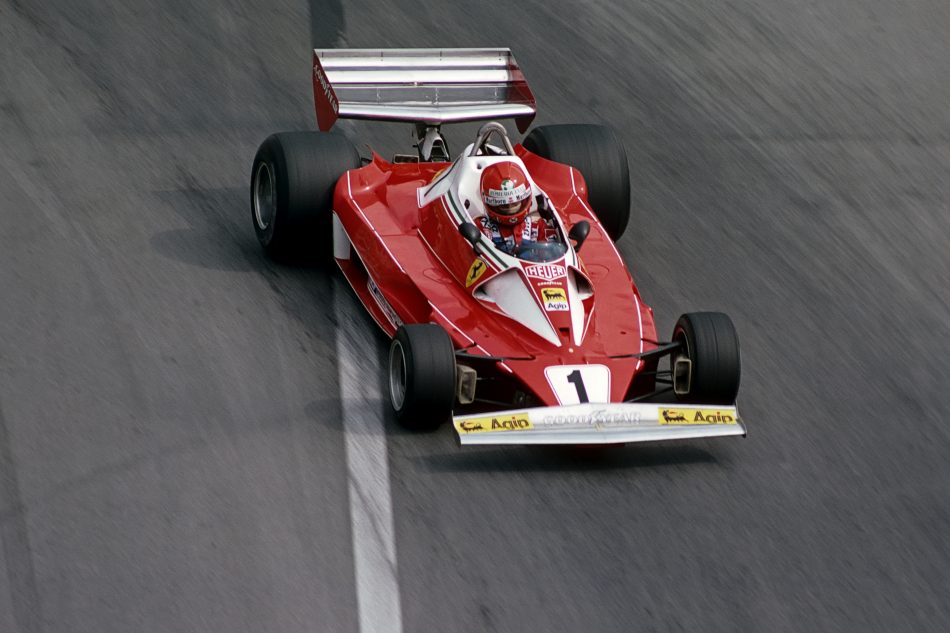
Chassis 026, the second of seven chassis numbers designated to the 312-T2 cars raced during the 1976 and 1977 seasons, still races forty years later under the capable care of Chris MacAllister. Chris knows a little bit about driving iconic, historic racing cars. “I had a McLaren Formula 1 car for years and been around racing for a long time, and I thought well if you could have any Formula 1 car you wanted, what would it be?” It did not take long for Chris to decide. “I liked the Lauda era and I liked the T2 better than the T and the T3 (1978). I liked the car because of its shape, because of its history between Lauda and Hunt. I always liked Niki Lauda; I followed him in the day.”
The most immediate difference between the T2 and its predecessor was the absence of the high airbox, a direct answer to the new regulations that would come into effect at the first European round of the 1976 season. Strikingly, Ferrari carved intakes into the cockpit surround ahead of the driver, channeling cold air around the cockpit to the cylinder banks. It was very different approach from many of the garagistas, who had merely lowered and refined the airbox shape behind the driver’s head.
The Fiorano debut (chassis 025) presented two features that never made it into competition. Most evident of these was a De Dion rear suspension. Forghieri believed that the long forgotten approach might serve to maintain a broader, more consistent contact patch with the asphalt, but tests did not convince Lauda and the approach would have placed great strains on Goodyear to produce unique tires for the 312-T2 alone. The new car also wore fairings ahead of the front wheels, incorporated as extensions of the front brake air ducts that turned with the wheels. For this reason they were deemed illegal as ‘moveable aero-dynamic devices’ and never saw competition.
The T2’s wheelbase was slightly longer, perhaps a result of Forghieri’s belief that the T did not perform on sweeping, constant radius corners. The new regulations also called for a front roll hoop to be incorporated at the instrument panel to provide better head protection in the event of a rollover.
However strained their working relationship often proved, (both men simultaneously praise and criticize each other to this day) Forghieri and Lauda’s collaboration resulted in one of greatest cars to ever compete in the F1 World Championship. The 312-T2 first appeared at the non-championship Daily Mail Race of Champions at Brands Hatch on March 14, 1976. Lauda started from pole in Chassis 025, but retired with brake issues after running in the top six.
Chassis 026 served Lauda well throughout 1976 to early 1977 and made its debut at Jarama, Spain on May 2, 1976. Lauda out-dragged James Hunt from Pole position, but ultimately crossed the line 2nd to Hunt’s McLaren M23 because he was racing with broken ribs!
026’ first victory came at the very next round in Belgium and Lauda then went on to completely dominate the Monaco Grand Prix two weeks later. Three Grands Prix and chassis 026 was already a world-beater. Quoted by Robb Walker in the September, 1976 issue of “Road & Track,” Lauda claimed, “I was never in any trouble. I had no trouble with the car and no trouble with myself. When I needed to go faster I could do it.”
No stranger to cars of the era, MacAllister explains just how unique the 312-T2 feels; “I had been running Cosworth-powered cars previous to that, in fact I guess it was a McLaren M19. It’s a nice car. I liked it, had a great time with it, but the Ferrari was different. Very different.
Right off the bat, the 312-T2 felt different than the Cosworth powered F1 cars I had owned previously. They have a distinctive feel, a vibration and sound. The Ferrari was much smoother, the engine revved seemingly with less effort. It just seemed more refined. The whole car had a certain synchronicity to it. Everything worked in harmony.”
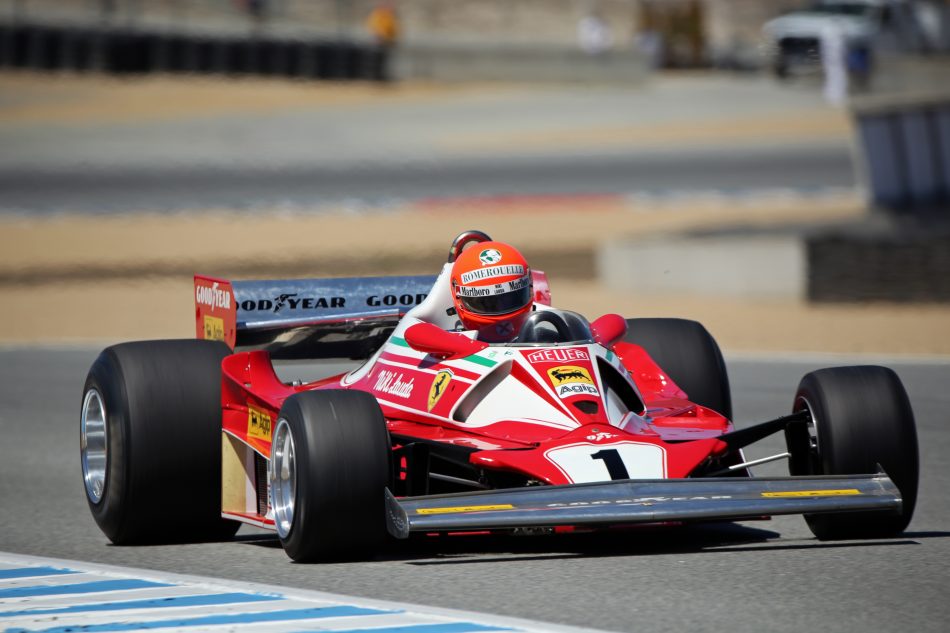
For certain, Forghieri had realized his long effort to extract a responsive power band and the 312B flat-12, and the motor delivered immediate torque over a range of 6000 revs. Lauda had often referred to the engine as “beautiful.”
“The engine has a broader power band than the DFV,” Chris continues. “There’s not a lot of power at 2000 rpm–the DFV will fall on it’s face and cough and slowly work its’ way up to 7500, at which point it takes off. The Ferrari comes in sooner; it starts pulling hard at 5000. It definitely has a broader power band. It’s easier to keep it in the power band and on short tracks where you’ve got lots of corners, that’s an advantage.”

Lauda’s decisive result on Monaco’s tight circuit intimated he was well on his way to securing his second drivers championship, but few could have foreseen the drama that lay ahead. After placing a curious third behind the six-wheeled Tyrells at the following race in Sweden, he suffered an uncharacteristic, catastrophic crankshaft failure while leading the French Grand Prix at Paul Ricard. James Hunt went onto win, a huge boost against the pointless Lauda heading to Britain.
Lauda took to a new 312-T2, chassis 028, at Brands. 026 assumed the role of the team’s T-car, a single spare permitted under the regulations of the day. The history books may have closed on 026, but for the infamous tragedy that would soon follow at Germany’s treacherous Nurburgring on August 1. Lauda crashed heavily, most likely as result of a broken suspension member, and chassis 028 was destroyed.
Lauda’s almost miraculous recovery after having been read the last rites put him back in the cockpit of 026 at Monza only six weeks later. Ferrari were caught off-guard, having poached his replacement in Argentinean Carlos Reutemann. To Lauda’s chagrin, Ferrari were left with no choice but to field three 312-T2 chassis for the Italian Grand Prix.
Commenting on his impressions of the 312-T2, Reutemann told Alan Henry; “I drove the T2 (Chassis 025) for the first time ever on the Thursday prior to the Italian Grand Prix. I tried it at Fiorano and then it was rushed up to Monza for me to practice the following morning. The engine had an incredible feeling of strength about it, plenty of torque and superb gear change…”
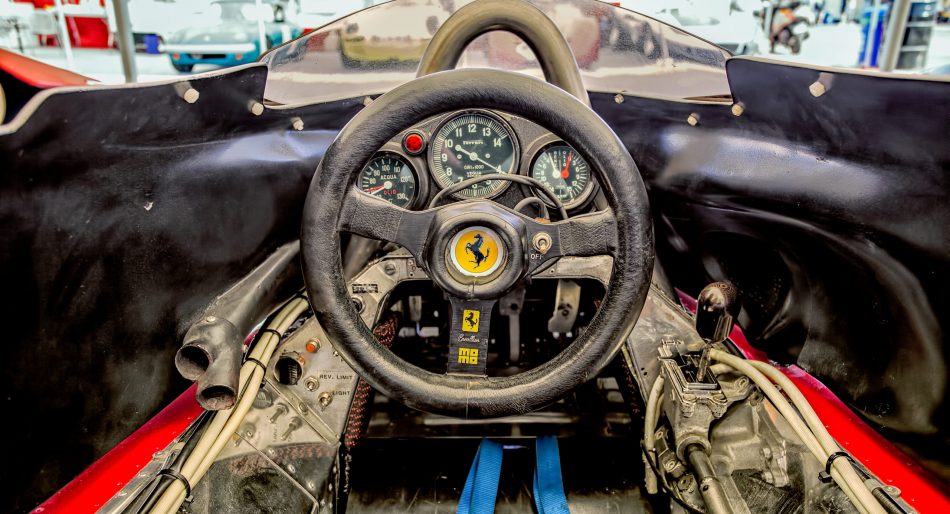
Chris echoes those sentiments today. “The gear shift lever is the best I have ever felt anywhere, on any car, ever. It is so precise and so smooth. There is no notchiness, no mis-shifting, there’s a very solid clunk when it falls into the detent and you just move your wrist, you don’t have to move your arm.”
Lauda qualified 026 the fastest of the three Ferraris for Monza, and might have won had he a better start. He soon realized, however, that Ferrari’s development of the 312-T2 had stalled in his absence. Lauda no longer enjoyed the advantage he had enjoyed before the accident. Following a couple of disappointing North American results, leaving him only a handful of points over a rallying Hunt, Lauda pushed for testing at Fiorano to improve the suspension before the team left for the final, championship deciding round at Fuji.
Thus 026 would set one more marker in F1 folklore when the rain delayed Japanese Grand Prix went before F1’s first worldwide TV audience. Unfortunately, the drivers’ safety concerns fell secondary to the quickly diminishing daylight the cameras required. Lauda reluctantly started but immediately fell back into the spray and purposely retired, climbing out of 026 after three laps, unwilling to accept a risk he considered too great. The championship was lost to Hunt, who narrowly took the title by a single point. Lauda found himself unofficially relegated to number two status behind Reutemann entering the 1977 season, and was not invited to participate in off-season testing.
The historical significance of the chassis is not lost on Chris, but as he campaigns 026 to this day, it is fair to say that he is more focused on sharing his ongoing passion than engaging in sentimentality. “I like driving at Monaco more than anywhere else because it’s got lots of elevation changes, a variety of corners, the harbor, buildings towering over both sides of the track, an incredible history and a certain ambiance like no other circuit. The 312-T2 is delightful to drive there because it has good downforce, is very nimble, and the engine’s torque makes it a pleasure to drive out of the corners.
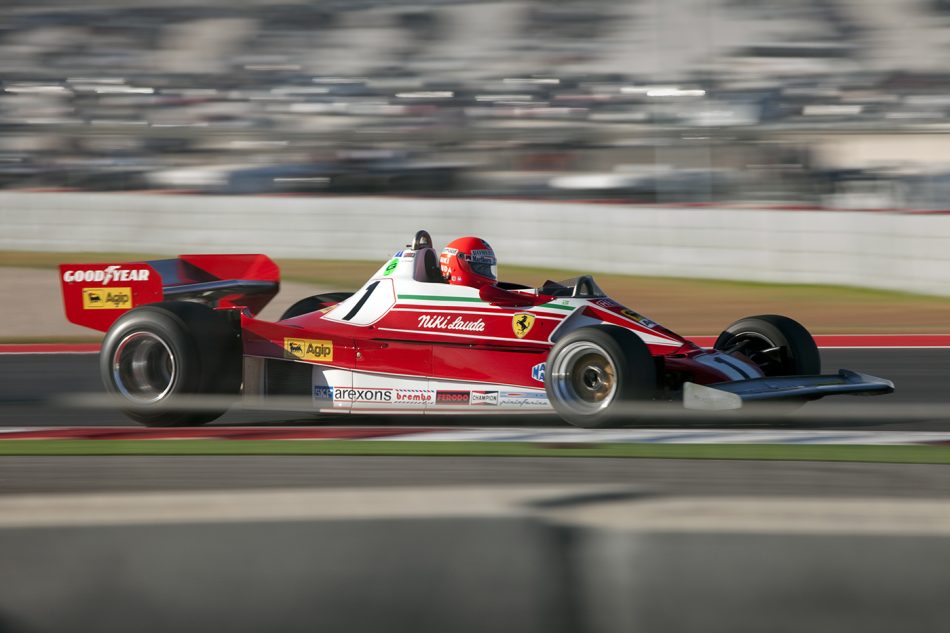
MacAllister, CoTA 2012
When I’m on the grid at Monaco, I’m very conscious of the car’s history and I’m generally reflective of how neat it is to be part of a large grid of excellent cars from that era. It’s really a privilege plus a whole lot of fun. I don’t feel like Niki Lauda (laughs), or anything like that, I guess I’m more thankful and appreciative.”
When Ferrari arrived in Buenos Aires to start the 1977 season, chassis 026 and 029 wore revised cockpit surrounds, a variation to the 312-T2 that would appear only twice. Unfortunately, the fruits of pre-season testing without Lauda were nominal, and the 312-T2 was no longer the class of the field. Jody Scheckter won Argentina in commanding fashion his first time out in the new Wolf WR1.

026 in it’s initial 1977 configuration
The second round at Interlagos would be 026’s swansong. Lauda and Forghieri tell differing accounts, but for whatever reason a single iteration of a new rear wing ended up on Reutemann’s chassis 029. Lauda struggled all weekend, with the car and with Forghieri, while Reutemann, enjoying the benefits of the new wing, won. Lauda came a frustrating third only because of his race craft and the benefit of attrition of faster cars ahead. Unglued, Lauda demanded Ferrari submit to exhaustive tests leading up to the South African Grand Prix at Kyalami.
026 was retired from competition. It is ironic and perhaps surprising that the 1976 Monaco victory proved to be the last time the car would cross the line in first place. Armed with a new car, chassis 030, bearing the fruits of his testing, Lauda took his first victory since the accident at Kyalami. He campaigned 030 until The French Grand Prix, before climbing into the last 312-T2 ever built, 031, which carried him to his second World Driving Title.
Lauda’s Kyalami tests resulted in the 312-T2’s final cockpit surround; featuring smaller but more efficient NACA ducts forward the driver. The modification resulted in what probably came to be the most recognizable version of the 312-T2. Ironically, this final ’77 spec never appeared on 026 in official competition, however Chris races with one in Monaco. Chris also constructed a replica of his preferred original ’76 design with the more dramatically sculpted intakes, which he often fits to 026 when racing in the states.
“I get a lot of pleasure and satisfaction out of just looking at that car. When it’s sitting there in the garage it just has a good shape. It’s cool to see it on a regular basis and when you take the cockpit surround off and the engine is exposed it’s a neat piece of machinery. It’s very different from a DFV powered car. There is more to see; the fuel injection metering unit, generator, ignition system, transverse gearbox, hoses and lines running all over the place. I find it more interesting than a McLaren, Brabham, or March.
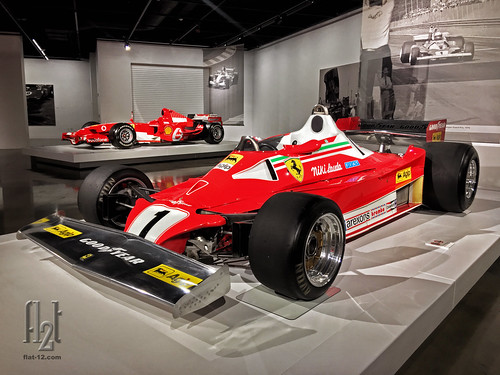
I appreciate the engineering and technology that went into it, and boy it’s fun to start too. There’s a routine you go through to richen up the mixture and you crank the engine over without fuel pressure or ignition to get oil pressure up and then you flip the switches and it fires up. It always fires quickly and it idles cleanly and smoothly and it’s just like a fine thoroughbred. It’s a pleasure to interact with it and to even see it… I mean most people don’t have that opportunity but for somebody that does… I’ve had the car I don’t know twenty years… every time I think, ‘boy this thing is cool and I’m lucky to have it,’ so there’s just a deep seated admiration and appreciation there.”

Lauda back behind the wheel of 026 at The Red Bull Ring
Ironically, 026 did not appear in Ron Howard’s RUSH, the 2013 release which recounted the amazing 1976 season. Lauda did re-unite with 026, however, returning to the cockpit for a demonstration run during F1’s return to Austria at the Red Bull Ring in 2014. Cheers to Chris for his stewardship, keeping 026 where she belongs: on circuit for all to enjoy.
Originally published in issue 204 of The Ferrari Club of America Quarterly, PRANCING HORSE.
Published here with permission.
Title image of Niki Lauda © Batchelor / XPB Images
Striking aluminum and acrylic prints of Chassis 026 can be found here
Tags: 026312-T2chassisFerrari 312-T2Mauro ForghieriMonaco Grand PrixNiki Lauda